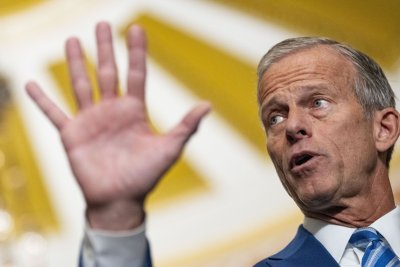Oral arguments over United States President Donald Trump’s power to impose tariffs have kicked off before a US appeals court after a lower court ruled he had exceeded his authority by imposing sweeping new levies on imported goods.
The appeals court judges on Thursday sharply questioned whether what Trump calls his “reciprocal” tariffs, announced in April, were justified by the president’s claim of emergency powers.
A panel of all the court’s active judges – eight appointed by Democratic presidents and three appointed by Republican presidents – is hearing arguments in two cases brought by five small US businesses and 12 Democratic-led US states.
The judges on the US Court of Appeals for the Federal Circuit in Washington, DC, pressed government lawyer Brett Shumate to explain how the International Emergency Economic Powers Act (IEEPA), a 1977 law historically used for sanctioning enemies or freezing their assets, gave Trump the power to impose tariffs.
Trump is the first president to use IEEPA to impose tariffs.
The judges frequently interrupted Shumate, peppering him with a flurry of challenges to his arguments.
“IEEPA doesn’t even say tariffs, doesn’t even mention them,” one of the judges said.
Shumate said the law allows for “extraordinary” authority in an emergency, including the ability to stop imports completely. He said IEEPA authorises tariffs because it allows a president to “regulate” imports in a crisis.
The states and businesses challenging the tariffs argued they are not permissible under IEEPA and the US Constitution grants Congress, and not the president, authority over tariffs and other taxes.
Neal Katyal, a lawyer for the businesses, said the government’s argument that the word “regulate” includes the power to tax would be a vast expansion of presidential power.
Tariffs are starting to build into a significant revenue source for the federal government as customs duties in June quadrupled to about $27bn, a record, and through June have topped $100bn for the current fiscal year, which ends on September 30. That income could be crucial to offset lost revenue from extended tax cuts in a Trump-supported bill that passed and became law this month.
“Tariffs are making America GREAT & RICH Again,” Trump wrote in a social media post on Thursday. “To all of my great lawyers who have fought so hard to save our Country, good luck in America’s big case today.”
But economists said the duties threaten to raise prices for US consumers and reduce corporate profits. Trump’s on-again, off-again tariff threats have roiled financial markets and disrupted US companies’ ability to manage supply chains, production, staffing and prices.
Dan Rayfield, the attorney general of Oregon, one of the states challenging the levies, said the tariffs are a “regressive tax” that is making household items more expensive.
Since Trump began imposing his wave of tariffs, companies ranging from carmaker Stellantis to American Airlines, temporarily suspended financial guidance for investors, which has since started again but has been revised down. Companies across multiple industries, including Procter and Gamble, the world’s largest consumer goods brand, announced this week that it would need to raise prices on a quarter of its goods.
The president has made tariffs a central instrument of his foreign policy, wielding them aggressively in his second term as leverage in trade negotiations and to push back against what he has called unfair practices.
Pressure outside trade
Trump has said the April tariffs, which he placed on most countries, are a response to persistent US trade imbalances and declining US manufacturing power. However, in recent weeks, he’s used them to increase pressure on nontrade issues.
He hit Brazil with 50 percent tariffs over the prosecution of former Brazilian President Jair Bolsonaro, a key Trump ally who is on trial for an alleged coup attempt after he lost the 2022 presidential election.
Trump also threatened Canada over its move to recognise a Palestinian state, saying a trade deal will now be “very hard”.
He said tariffs against China, Canada and Mexico were appropriate because those countries were not doing enough to stop fentanyl from crossing US borders. The countries have denied that claim.
On May 28, a three-judge panel of the US Court of International Trade sided with the Democratic states and small businesses that are challenging Trump.
It said IEEPA, a law intended to address “unusual and extraordinary” threats during national emergencies, did not authorise tariffs related to longstanding trade deficits. The appeals court has allowed the tariffs to remain in place while it considers the administration’s appeal. The timing of the court’s decision is uncertain, and the losing side will likely appeal quickly to the US Supreme Court.
The case will have no impact on tariffs levied under more traditional legal authorities, such as duties on steel and aluminium. The president recently announced trade deals that set tariff rates on goods from the European Union and Japan after smaller trade agreements with Britain, Indonesia and Vietnam.
Trump’s Department of Justice has argued that limiting the president’s tariff authority could undermine ongoing trade negotiations while other Trump officials have said negotiations have continued with little change after the initial setback in court. Trump has set a deadline of Friday for higher tariffs on countries that don’t negotiate new trade deals.
There are at least seven other lawsuits challenging Trump’s invocation of IEEPA, including cases brought by other small businesses and California.






